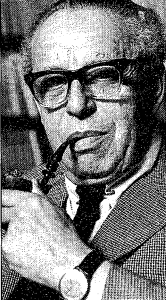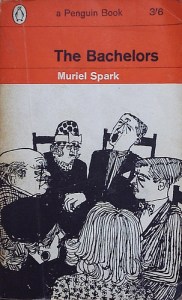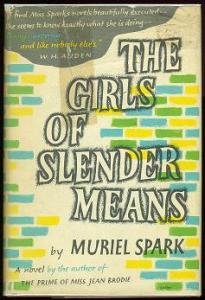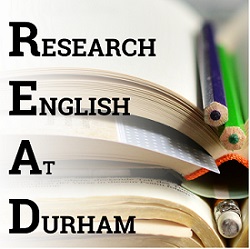Ellic Howe’s ‘The Documentary Weapon’ and Forgery in Muriel Spark’s The Bachelors (1960)
Beatriz Lopez explores connections between the PWE’s use of forgery in wartime propaganda campaigns and Spark’s later interest in the practice in her novel The Bachelors (1960)
In the summer of 1941, the printer and typographer Ellic Howe was serving as a Sergeant-Major at Anti-Aircraft Command Headquarters. Convinced that his printing skills could be put to good use in the war effort, Howe wrote a paper on the use of forgery in wartime – ‘The Documentary Weapon’ – which found its way on to the desk of Leonard Ingrams, an Under-Secretary at the Ministry of Economic Warfare who led the Letter Writing Unit responsible for disseminating propaganda via post. Impressed by Howe’s paper, Ingrams called him in for a meeting, and promptly appointed Howe as the PWE’s print production manager in November 1941.[1]

Howe’s paper argues that written communication is superior to oral communication since ‘people will generally consider any piece of writing, set up in the style to which they are accustomed, as valid, genuine and delivered in good faith.’[2] In addition, written discourse could address individuals who may be ‘outside the reach of our armoured divisions or agents.’[3] Howe emphasised that the success of printed materials depended on the ability of these to appear plausible to their recipients: ‘the writer is not primarily concerned with the literary or verbal contents of any document, except in so far as they control format, layout and design; nor in the manner of the document’s “planting” or use, except in so much that the document must not betray its bearer.’[4] Such plausibility can only be achieved through expert knowledge of documentary conventions – ‘process, format, type face, paper handwriting, “style”’ – which would prevent the propagandist from making a mistake that might disclose the document’s real provenance.[5]
The documentary intelligence expert must be particularly well versed in ‘the essentials of a “National Style” by the examination of large numbers of documents, ranging from books to visiting cards by way of newspapers, income tax forms, letterheadings, handbills, etc.’, in order to grasp ‘the essence of the enemies stylistic practice.’[6] Howe believed that the reproduction of the enemy’s “National Style” would enable the PWE to mimic German documents and publications with such a degree of verisimilitude that German citizens would recognise and trust these as genuine. The value of PWE printed materials thus relied on the PWE’s ability to simulate what Michel Foucault would go on to describe as the ‘author function’ – ‘a certain discursive set’ with status ‘within a society and a culture’ – of the German government it was trying to defy.[7]

Muriel Spark’s fiction is plagued by forgeries which reflect many of the issues raised by Howe’s paper, suggesting that her PWE experience might have encouraged her fascination with the precarious nature of authenticity and its perpetual haunting by the prospect of textual manipulation. In The Bachelors (1960), for example, an alleged forged letter becomes the main driving force of the plot. Fraudulent spiritualist Patrick Seton is accused of having forged a letter in which widow Freda Flowers offers him £2000 to further his spiritualist work when, in fact, Freda’s cheque was to be invested in bonds on her behalf. Ronald Bridges, an ‘assistant curator at a small museum of handwriting’ who has gained ‘a reputation in the detection of forgeries’, is tasked with evaluating the authenticity of the letter.[8]
In this pursuit Ronald adopts scientific methods which are presumed capable of determining with maximum accuracy the authenticity, or lack thereof, of a document. As Ronald’s friend Matthew boasts,
‘He puts these documents to all sorts of tests – don’t you, Ronald? There’s a test for the ink, and the paper, and all the folds. The most important thing is the formation of the letters – anyone can do the rest, but Ronald’s the best man for detecting the formation of letters. And sometimes the forger has stopped to assess his handiwork and then retraced. That’s fatal because there’s an interruption in the writing which can be detected under the microscope, at least Ronald can detect it – can’t you, Ronald?’[9]
Such interruption in the formation of letters is perceived to be the result of the forger’s self-consciousness about the process of writing, which confirms the fact that ‘a forger is in fact often caught because of the “unnatural” relations between himself or herself and the document.[10] In addition, the self-consciousness that leads to implausible writing is also evident in the folds of the paper. As Ronald explains,
Sometimes a line has been inked over after the fold has been made. The forger very often has second thoughts about the job after the paper has been folded, and to make everything perfect he unfolds the paper again and he touches something up; let’s say the stroke of an “f”. It’s possible to see under the microscope if that sort of thing has been done.[11]
Although Ronald’s forgery detection is based on the examination of variations in handwriting, a question with seemingly little relevance for PWE propagandists producing printed materials, his concern with stylistic plausibility resonates with Howe’s PWE work. For example, Howe disliked the standard method for creating counterfeits, which involved ‘the longwinded and meticulous retouching of enlarged photographic copies’, favouring instead the production of ‘a document from scratch utilising the correct Fraktur typefaces of the original.’[12] While Howe instructs PWE propagandists on the stylistic matters that must be attended to in order to make a document appear plausible, Ronald is responsible for tracing the mistakes that give away the falsity of documentary evidence.

Spark does not mention Howe in her autobiography Curriculum Vitae (1992) and it is unclear whether their paths ever crossed. Yet Spark is likely to have been acquainted with Howe’s work for her boss Sefton Delmer, which may have well encouraged the subsequent problematization of authenticity and authorship in her fiction. In fact, textual manipulation – either in the shape of counterfeits, forgery, or plagiarism – would go on to feature not only in The Bachelors (1960), but also in The Girls of Slender Means (1963), Loitering with Intent (1981), A Far Cry from Kensington (1988) and Aiding and Abetting (2000).
Notes
[1] Charles Cruickshank, The Fourth Arm: Psychological Warfare 1938-1945 (Oxford: Oxford University Press, 1981), 35.
[2] The National Archives (TNA), Allied Propaganda in World War II: The Complete Record of the Political Warfare Executive (FO 898). Accessed via Archives Unbound (Gale). <https://www.gale.com/intl/primary-sources/archives-unbound>. FO 898/61, Policy Meetings and Correspondence. 1941-5.
[3] FO 898/61, Policy Meetings and Correspondence. 1941-5.
[4] FO 898/61, Policy Meetings and Correspondence. 1941-5.
[5] FO 898/61, Policy Meetings and Correspondence. 1941-5.
[6] FO 898/61, Policy Meetings and Correspondence. 1941-5.
[7] Michel Foucault, “What is an Author?” in James D. Faubion (ed.) Essential Works of Foucault, 1954-1984, Volume II: Aesthetics, Method and Epistemology (New York: The New Press, 1998), 205-22, 211.
[8] Muriel Spark, The Bachelors (Edinburgh: Polygon, 2018), 1, 11.
[9] Spark, The Bachelors, 83.
[10] Susan Stewart, Crimes of Writing: Problems in the Containment of Representation (Durham and London: Duke University Press, 1994, 24.
[11] Spark, The Bachelors, 181.
[12] Lee Richards, The Black Art: British Clandestine Psychological Warfare against the Third Reich (Peacehaven, East Sussex: www.psywar.org, 2010), 21.
